Pemberton Technologies HMAS Bonestell
Pemberton Technologies - HMAS Bonestell {Kit}
Contributed by John Lee
| Construction Rating: | starstarstarstarstar_border |
| Flight Rating: | starstarstarstarstar_border |
| Overall Rating: | starstarstarstarstar_border |
| Manufacturer: | Pemberton Technologies  |
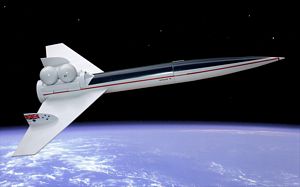
Brief:
I was fortunate to place in a monthly rocket contest on TRF in which the prize was any of Pemberton Technology's LPR
kits. The dilemma was that I already had all his kits. Layne Pemberton came through like a champ though and offered me
the opportunity to try out a preproduction model of his upcoming HMAS Bonestell, influenced by the artwork of Chesley
Bonestell. It feels like it should have been a first prize instead of a runner-up, but I am not complaining!
Construction:
The instruction for this kit have not yet been put together. I had to work from the parts and a collection of photos
on a CD Layne sent me. My first step was to import the photos into Adobe Pagemaker and try to get them into order. With
that done, I printed out my "instructions" and was ready to get to work.
I identified the body tube as a BT-60 so went into VCP and generated a wraparound marking guide with 4 lines at 90 degrees. Only 2 would truly be for fins but I needed the other two for the tanks to come. I cut out the template, was pleased to see that it fit, transferred the lines and extended them the length of the tube.
The fins for this beast are cut from a very nice sheet of balsa using a paper template that shipped with the kit. The template was cut out and laid onto the balsa. I did notice that the photos I had showed a chamfer at the root/trailing edge and the template did not. This began to make sense when I realized that the chamfer is a result of the template not fitting completely onto the balsa stock. I liked to look of the cut corner. The fins were cut out with a razor knife and the leading edges were rounded.
With the fins being ready, I laid a fin along the fin line on the BT and marked the forward and aft extension of the TTW tab. I did the same with the opposite fin and then used a razor to cut the slots for the through the wall mounting. The fins were then test fit to make sure everything fit.
Motor mount construction was begun by designating one end of the motor tube as aft and measuring 5/8" forward of that. A centering ring was then glued into place at that mark and filleted only on the aft side.
When that centering ring was firmly dried, I took one of the fins and set its tab up against the ring, laying the length of the tab flat along the motor mount. The tabs of the fins have to fit within the centering rings so I wanted to make sure the forward ring would have clearance. I marked where it should go and then marked the opposite side with the other fin just to make sure. Fortunately, they were the same. The forward centering ring was then glued into place along the marks and filleted on the forward side.
The rings on the motor mount were given a day to dry and then the assembly was test fit into the body tube. I found that the forward ring needed just a little bit of sanding to slip in well. Once in place, I wanted to make sure that the fins would clear the rings when inserted into the slots. They did and the fins an motor mount were removed again.
One of the more unique visual elements of this kits is the inclusion of four plastic Christmas tree balls to be used as fuel tanks. The hangers were removed (but retained) and then the body tube was made ready to receive them. The appropriate distances were marked off along the lines 90 degrees from the fin slots and four holes were drilled. The balls were then test fit and the lips on their mount popped right in. The balls were then removed.
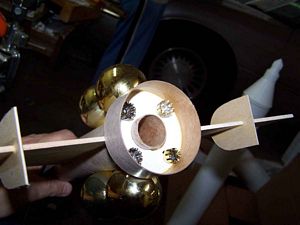 Since everything seemed to fit, it was time to install the motor mount for real
but I remembered one change I wanted to make. The intention of the kit was to use a LOC style shock cord mount. I
decided to tie some Kevlar®
around the motor mount and cut a notch to pass it on the edge of the forward ring. This was done and the Kevlar®
was filleted in with some glue. I then passed the cord through the motor mount, swabbed the interior of the BT with
glue, and shoved the mount in place, trying to ensure that the centering rings did not interfere with the fin slots.
Since everything seemed to fit, it was time to install the motor mount for real
but I remembered one change I wanted to make. The intention of the kit was to use a LOC style shock cord mount. I
decided to tie some Kevlar®
around the motor mount and cut a notch to pass it on the edge of the forward ring. This was done and the Kevlar®
was filleted in with some glue. I then passed the cord through the motor mount, swabbed the interior of the BT with
glue, and shoved the mount in place, trying to ensure that the centering rings did not interfere with the fin slots.
As the motor mount was drying in place, I turned my attention to the beautiful, slender nose cone. It was nicely turned balsa. I decided to harden and seal it with thin CA and drizzled some on and set it aside to dry.
The glue on the rocket was given a full day to dry and then mounting of the fuel tanks began. It was simply a matter of applying some CA and popping them into their holes.
With the tanks in place, final installation of the fins began. Each was mounted with a double joint of yellow glue. Fillets of white glue were then applied along the root edges.
The tail end of the rocket features a large ring and bulkhead. As the fins were drying, I began assembly on it. The centering ring was sanded around the edges to make it fit and then inserted into the ring BT and pushed flat against the forward edge. It was then glued into place with yellow glue.
The tail ring assembly dried for a few days before I took it back up again. When I did, I could not just "go at it" because I had earlier lost one of the hangers from the balls and all four were needed at this stage. I considered spacing three evenly around the back and that would of looked fine but the rest of the rocket features items in "4 packs". I went against my nature and decided to wait for Layne to come through.
What I did do was to use the hangers I had to mark the places on the bulkhead of the ring assembly and get them spaced evenly. I then used a razor knife to open up a small slot to accommodate the slot in the hangers. They were purposely left small so that I could whittle away as needed. Eventually, it was big enough to accommodate the hanger and it was test fit. I went ahead and cut the rest of the slots and then put this assembly away to wait.
I could get back to work on the fins. I measured a distance 3" from the BT on each fin and then measured a tick mark 1/2" long from the trailing edge. The fins were then notched to a depth of 1/2", parallel to the BT, about 1/16" wide in order to accommodate the rudders.
I had long noticed in the bag of parts a piece of laser cut balsa with the rudders on them. About this point though, I finally fished the balsa out only to find that I had been deceived. It was plywood. The outlines of the rudders had been drawn on and I had to cut the things out. There are three probably reasons for this:
- Layne doesn't like me very much.
- Layne gets a kickback from the sale of X-Acto blades.
- The plywood will stand up to the stresses of flight at the extremities of the wings better than balsa.
In reality, its probably a combination of all three. In any event, I started tracing of the outlines with fresh X-Acto blades and eventually had the things cut out.
The rudders were test fit and some last minute trimming was done and then they were glued into place with yellow glue. When they had dried, they were filleted with white glue and everything was set aside for a while since I had to leave town for a few days.
When I got back to town, I test fit the three original ball hangers on the aft bulkhead without gluing them. I then added in the replacement. The new one was just slightly bit different than the rest, having a slightly smaller diameter. One of the originals had a slightly lighter color as well. The paint job would take care of the color issue and the diameter was not enough to be a real issue to me. I checked on the forward side of the bulkhead to see how much of the hanger protruded through. Not much did.
At this point, I resisted the impulse to glue the hangers in place. Instead, I test fit the entire assembly onto the protruding motor tube. I was forewarned that I would need to notch the wings to accommodate the ring but that was not really a problem. The problem I had was that my placement of the hangers was a bit too far towards the center. Where the hangers protruded through the forward side interfered with the body tube of the rocket. To make things work with their current placement, I would have to notch not only the wings but the BT as well. This was going to need some modification before proceeding further.
The fix was not all that difficult. I just lengthened the slots through which the hangers were put and slid them out a bit. About the time that was done, I heard from Layne Pemberton that such was his recommended procedure as well. As Uncle Louie used to say, "even the blind pig finds a truffle every now and again." I placed the hangers back in the aft bulkhead and everything fit right so I used CA to fix the hangers into place and then glued on the aft ring with yellow glue.
The Bonestell has 4 tanks running parallel with the long axis and constructed from BT-5. I took the piece of tubing I was sent and marked off 4 pieces at 4-1/8" apiece. Tape was then used to define the proper circumference along which to cut. A mandrel was inserted and the tanks were cut to length.
Each of the tanks was to be capped at either end. From examining the photos, I had assumed that the caps were made of Tyvek or something similar but did not find any such material in the bag. I then realized that I had bee working only under my own assumption. It was quite likely that the caps were to be made from ordinary bond paper. I cut a strip into segments big enough to cover the ends and then placed them with thin CA. The process was then repeated for the opposite ends of the tanks.
The tank caps were allowed to dry and set up over night and then a razor knife was used to trim away most of the excess material. Sandpaper was then used to clean up the edges around the perimeter.
The long tanks were supposed to be mounted on the body tube, over the ornament hangers and tangent to the balls. There was some question in my mind as to whether the rear sheathing was to be pierced or if the tube was to leave the hanger exposed. I finally decided on the latter for 2 reasons. It made no sense to cover the end of the tube if it was going to be hidden and because I was impatient and didn't want to wait around for an answer.
The long tanks were applied with yellow glue and it became clear that I had not gotten everything perfectly aligned, but it was good enough for me.
The next few photographs were pretty clear as to what needed to be done. I was to cut 4 strips of balsa that were 3/8" wide by 4-5/8" long. Presumably this was to come from the fin stock. The problem was that I had butchered the fin stock in making the wings and the scraps were no longer available.
A check of the fins showed that they were 1/8" thick which was great since I had plenty of 1/8" stock...except that I didn't. 1/16" was the closest I could come up with. I decided to cut double the number of strips and laminate them together in pairs. I glued the two pieces together with yellow glue and "clamped" them with clear tape to dry.
While the beams were setting up, I turned my attention to the two arcs that were to be cut from BT-60. I needed a piece of BT-60 5/8" long and this was cut from some scrap I had laying around. From this short section I had cut down I needed to cut 2 pieces, each a specified length along its arc. To do this, I measured the length off on some bond paper, cut it out, and then taped the paper to the tube. The paper was then used to mark the tube the correct arc length and the arcs were cut out. Cutting out the arcs had given the beams time enough to set up so I undid the tape and sanded them even. Yellow glue was then used to place them so that the narrow edge was tangent to the body tube and the wide edge was tangent to the long tanks.
As I let the beams dry, I started searching for the nose cone. I finally found it and located the screw eye as well as two steel washers provided as weights. I twisted the screw eye into place and then removed it. Some 5 minute epoxy was put in the hole and smeared on the base of the cone. A washer was then set in place and some more epoxy put on it after which the second washer was put in place. The screw eye was then screwed back into place to hold everything together as the epoxy set up.
I spent a little bit of time coaxing the BT-60 arcs I had cut into a bit more open of a profile. I then test fit one of them using the beams as anchors and pressing the ends of the arcs down until they were at the intersection of the beams and body tube, however, they kept wanting to pop out.
My first attempt to glue them in place used a bit of yellow glue to tack one end. I realized almost immediately that I was doing things the hard way, wiped the glue off, and let it dry completely. When it had dried, I placed one end back in place and then tacked it with CA. A few moments later, it was set in place and I tacked the other side. The process was then repeated for the arc on the other side. After giving the CA a decent amount of time to dry, I filleted/faired the joint with a modicum of white glue.
Layne had sent me an email on how the launch lug was supposed to be attached. I lost it before I ever did much more than skim it. As I looked at the lug, it was a short piece of tubing for a 1/4" rod. It was not long enough to steady the rocket by itself. Furthermore, there was that projection at the aft bulkhead to consider. I did remember the email saying something about drilling and then I realized that I could place the lug near the forward end of one of the wing roots and then drill a 1/4" hole in line with it through the bulkhead. I put a 1/4" bit in the chuck and drilled through adjacent to the wing. I then used a piece of 1/4" rod to line the hole up with the lug and placed the lug with some yellow glue.
Finishing:
I prefer Elmer's Wood Filler to balsa fillercoat, but in this instance it seemed to me that the fillercoat would be
easier to handle because it would be slightly more forgiving in all those hard to sand areas. With that in mind, I gave
the balsa, including the CA hardened nosecone, 3 coats of sanding sealer, sanding between each coat.
Priming of the Bonestell was done with Kilz. The rocket got several coats of the stuff and was sanded between coats. Getting into the tight places especially around the tanks took time and effort. The humidity around home while this was going on also meant that there was a long drying time between coats. After the final priming, the rocket got a thorough final round of sanding to wear down some of the blobs that had built up.
The basic paint scheme I used was gloss white in a vain and ill fated attempt to duplicate Layne Pemberton's masterful finish. The rocket got 2 coats.
When the white had dried, I began masking for the black. I could say that my masking scheme differed from Layne's because I wanted to show some individuality but the truth is that I didn't have a photo and I winged it. I did give a long "canopy" along the top but mine is shaped a bit different. I also provided for a black panel on the upper surface of each wing.
The rocket was taken to the booth and shot with gloss black. After about half an hour, my patience could stand no more and I peeled off the masking. Layne's is prettier but I'm happy with mine.
Layne's prototype had a nice set of red pin striping. I think he enjoyed frightening me that they were painted on. If that was the case, I would have been doomed, but he fessed up and revealed that he had used automotive pinstriping. I went to a local auto parts place and picked up a roll of red in the narrowest size they had. It looked about right.
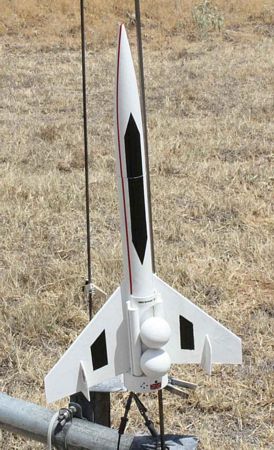 To apply the stripes, I dusted off the model and cut a section of striping a bit
longer than needed to run from the arcs in front of the tanks to the nose cone. I then used a razor knife to tease the
backing away from the vinyl and set the aft end into place. The backing was then slowly peeled off as I extended the
stripe to the tip of the nose cone. When it was in place, I used the razor to cut off the excess and to slice the
stripe at the nose cone joint. The stripes definitely dressed it up a lot.
To apply the stripes, I dusted off the model and cut a section of striping a bit
longer than needed to run from the arcs in front of the tanks to the nose cone. I then used a razor knife to tease the
backing away from the vinyl and set the aft end into place. The backing was then slowly peeled off as I extended the
stripe to the tip of the nose cone. When it was in place, I used the razor to cut off the excess and to slice the
stripe at the nose cone joint. The stripes definitely dressed it up a lot.
Layne sent me a set of decals after I had started construction. They were simple and consisted of four representations of the Union Jack with the Southern Cross superimposed (For Australia). There was also a smaller strip with the same logo and the words, "HMAS Bonestell". On his model, I remembered seeing the main logo on the rudders but could not remember where the rest went. I decided to make it up as I went along and that got me into trouble. In the first place, I did not notice that half were reverse images and had assumed that they were all the same. So it is that I have the jack on the forward edge of the rudder on one side and the constellation on the leading edge on the other. Oops.
That left me with 2 more and I could have put them on the inner surfaces of the rudders but I decided to use them on the tail ring instead. I applied them and like the way they looked...until I took a closer look at the small decal with the lettering. When I looked at the smaller decal I immediately knew something was wrong. Apparently my store of vexillological lore is less than I had supposed. I had the decals on the rudders and tail rings upside down. In any event, I applied the lettered decal on the dorsal arc and I still think it looks good there.
Even though I blundered, I think the result is a nice looking ship. I am satisfied and want to take this opportunity to express my apologies to the officers and crew of the Royal Australian Space Navy and to Aussies everywhere. No offense was intended.
Construction Rating: 4 out of 5
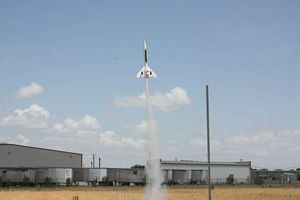
Flight and Recovery:
The day of the maiden flight arrived and I packed an 18" nylon chute and a D12-3, the smallest motor Layne
recommends. The rocket got plenty of oohs and aahs on its way to the pad. Ignition was almost instantaneous and the
rocket started up straight. About a hundred feet up, though, it began to corkscrew, getting wilder with time. Ejection
occurred at apogee and the chute deployed fine; things began to look up. In fact, the Bonestell looked very nice
swinging down under its canopy. There were no wild gyrations that so many of my rockets exhibit. It landed close by.
When I got to it, I found no damage at all and was ready to try it again.
For the second flight I decided to try and E9-4. The rocket was prepped as before and put on the pad. Liftoff was as before and began straight. After about 100 feet though, the corkscrewing began and continued to increase in magnitude until ejection. Ejection occurred normally and the chute deployed. Again, I noted that there were no oscillations. The rocket seemed to have gotten that out of its system on the way up. I also noted that it took a long time to come back down and wonder if it caught a thermal. In any event, I am glad to report that it recovered unharmed.
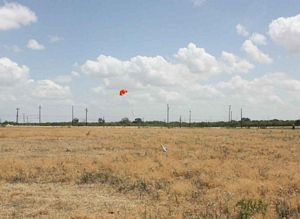
Flight Rating: 4 out of 5
Summary:
I'd like to commend Layne Pemberton on his innovative "gyroscopic ascent stabilization", also known as GAS,
but that would be unfair. The corkscrewing I experience is almost certainly due to my not getting something straight. I
suspect the rudders were the culprit. It seems to me that the increasing magnitude of the oscillations with time is
probably due to the increased velocity of airflow with time. In any event, this rocket was fun to build and is a unique
looker. Anybody wishing to follow
the chronicles of this rocket is invited to click here.
Overall Rating: 4 out of 5
 |
 |
Flights
Sponsored Ads
 |
 |











